#San Francisco Bay Railroad
Explore tagged Tumblr posts
Text

Justin Franz "San Francisco Bay Railroad S-2 No. 23" Alco S-2 rolls to a stop near the railroad's office on Cargo Way after switching a cut of cars dropped off by the Union Pacific. The locomotive has the distinction of being one of the last working Alcos in California (Napa Valley's FPA4s also coming to mind, but regardness, there aren't many). Next to No. 23 is the hood from SFBR No. 25, which is currently out-of-service https://flic.kr/p/Jfojf4
15 notes
·
View notes
Text

Bottleneck
This railroad tunnel is 6 miles long and it cuts under the Continental Divide west of Denver Colorado. During World War II it was an important factor impacting the war in the pacific. Tens of thousands of US soldiers and their material needed to land across contested beaches and that required landing craft. So many landing craft were needed (nearly 100,000 worldwide) that extraordinary actions were called for. One of the strategies employed was to prefabricate landing craft sections in Denver, Colorado to be shipped by the trainload to Mare Island Naval shipyard for assembly. This tunnel limited the size of the sections that could be shipped, but in the end, it made little difference. Mare Island built so many tank landing craft (LCTs) in the building ways that, if they were laid end to end, they would stretch for 6 miles. Sadly, these LCTs would be the last piece of sovereign US territory that many service personnel would set foot on before being killed in action.
Dennis Kelly
#mare island#naval history#san francisco bay#us navy#vallejo#san francisco#LCT#Landing Craft#world war 2#world war ii#world war two#Moffett#Tunnel#Railroad#tank landing craft
5 notes
·
View notes
Text
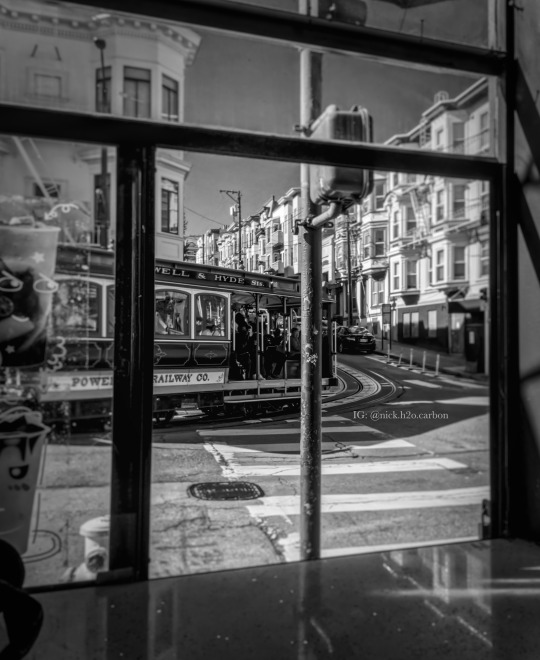
Corner snap 📸 as I wait for 🍿🐣 in San Francisco. Good views and good chicken.
📍Powell St. San Francisco
#san francisco#california#black and white#original photographers#photooftheday#lumix#cable car#railroad#public transportation#bay area#photography#street photo club#USA
21 notes
·
View notes
Text
Visited the California State Railroad Museum in Sacramento, and they had a scale model railroad display. I honestly like seeing them to learn what I can for my own craft. This was one of them.
Lime Kiln
The Lime Kiln diorama, based on an actual set of lans in Felton, California, was built by the late Jim Vail. Look for the miniature workers in the kiln, and the detail of the limestones as they are processed. The lime from Felton was used to make cement for the growing city of San Francisco and surrounding Bay Area cities.
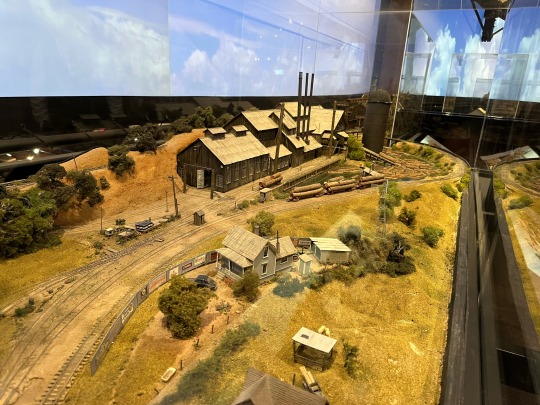
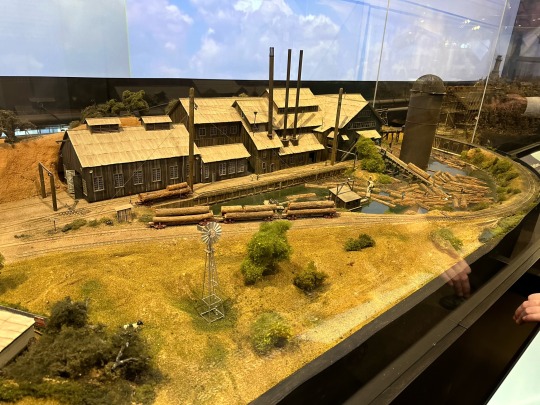
West Side Lumber
Located in Tuolumne, a small city in the Sierra Foothills, the West Side Lumber Company once operated an extensive logging operation served by a narrow gauge railroad. This HO scale model by Jim Vail is a foreshortened representation of the sawmill, which was modified to include a small farm scene.
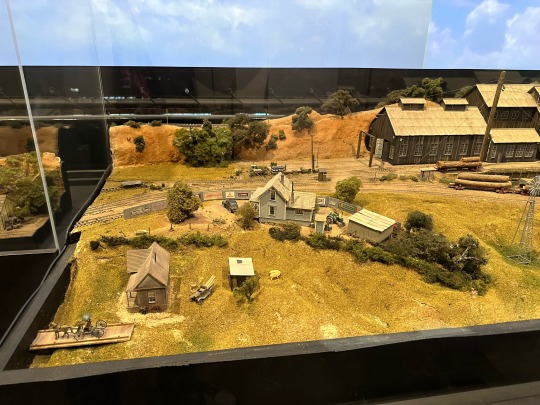
#miniatures#minipainting#terrain#terrain inspiration#diorama#model railroad#model railway#scale model#scale model railroad#railroad museum#modelrail#modelrailways#model
99 notes
·
View notes
Text

Sunday, 11-17-24, 2pm Pacific
Aaaaaand it's a sunny afternoon here in the San Francisco Bay, I hope everyone has had a good day so far. Mr. Baggins here with your Afternoon Stack of Classic Wax. I've been having a "slow re-entry" kind of late-morning Sunday sorta day, and I'm ready to shift gears a little...are YOU ready? Pacific Gas & Electric wants to know!
youtube
Here's one of Badfinger's best songs from '70, their second single issued in America. This one hit the top 10, and deservedly so!
youtube
Another band from England that broke big in 1970, Free, had this monster hit in 1970 as well. Here's the shortened single version that we heard on the radio of "All Right Now".
youtube
Three Dog Night were ascending to Rock Legend status in '70 with a string of huge hits, including this one: Celebrate!
youtube
This one is an old friend for me...first planting the idea of San Francisco Bay in my little eleven year old head. The decades have flown by...it took me another 45 years to make it here, but my attachment to this tune has never wavered. Here's Blues Image with their one hit, "Ride Captain Ride".
youtube
I have always followed that song up with this one in my head, for obvious reasons, but it still makes a great combo. Here's Grand Funk Railroad with their single, "Closer to Home"
youtube
Looks like we're in a 1970 kinda mood today, but that's ok, because here is another monster hit from that year, from jug band "Mungo Jerry". They hit it big with "In The Summertime". Ya gotta love a song that has the line "We're no threat, people! We're not dirty, we're not mean! We love everybody but we do as we please!"
youtube
Now here's a band that was part of "The Dutch Invasion" that happened in 1969 and 1970. These guys and label-mates Shocking Blue were both ridin' high in '70, and even little eleven year old me knew this was about weed! Here's The George Baker Selection with "Little Green Bag"..."Got to find just the kind for losin' my mind!" indeed!
youtube
Let's hear from those label-mates, Shocking Blue, with the song that was Number One on my birthday in 1970, the ingrained-in-our-dna "Venus"!
youtube
I've got one more 45 from 1970 in our daily Afternoon Stack of Classic Wax for this Sunday afternoon, the feel-good tune "Montego Bay", by Bobby Bloom.
youtube
That's all the space i've got for this afternoon, but I'll be back at 7pm Pacific with your Sunday Serenade, music to soothe your achin' nerves and help ease us all into a good night.
Until then, be kind, babies, be kind.
Baggins out.

9 notes
·
View notes
Text
The term "oyster pirate" appeared in several literary works by Jack London. London usually used the term without explanation ("I wanted to be where the winds of adventure blew. And the winds of adventure blew the oyster pirate sloops up and down San Francisco Bay"). Writers about London also use the term without explanation ("he was a sailor, seal-hunter, tramp, fish warden, oyster pirate, cannery worker, jailbird, boxer, and gold digger"), as if everyone knew the meaning of the term.
In the context of Jack London's life, it refers to a specific set of conditions peculiar to the oyster industry in San Francisco Bay in the 1880s. While San Francisco Bay had a native oyster (the same species found elsewhere on the Pacific Coast), it was never very abundant. By the early 1850s, entrepreneurs began importing oysters from Shoalwater Bay (now Willapa Bay), Washington Territory. Native West coast oysters were much smaller and had a different flavor from those from the East coast. When the transcontinental railroad was completed, large fishery companies in the east sold juvenile oysters to San Francisco entrepreneurs who purchased submerged land from the State of California and grew oysters from transplanted Eastern stock.
By the 1880s the handful of competing oyster companies began consolidating into a single monopoly. Their harvest of a private commodity from a public space, the San Francisco Bay, led to an opportunity for oyster pirates. Pirates raided the oyster beds at night and sold their take in the Oakland markets in the morning. The public disliked the Southern Pacific and the oyster growers, and liked cheap oysters. As a result, the oyster pirates had considerable public sympathy and police were reluctant to take action against them.
31 notes
·
View notes
Text








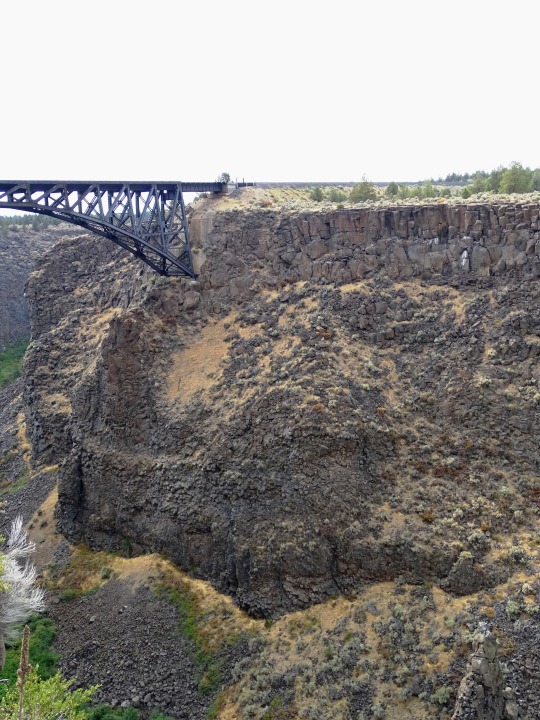
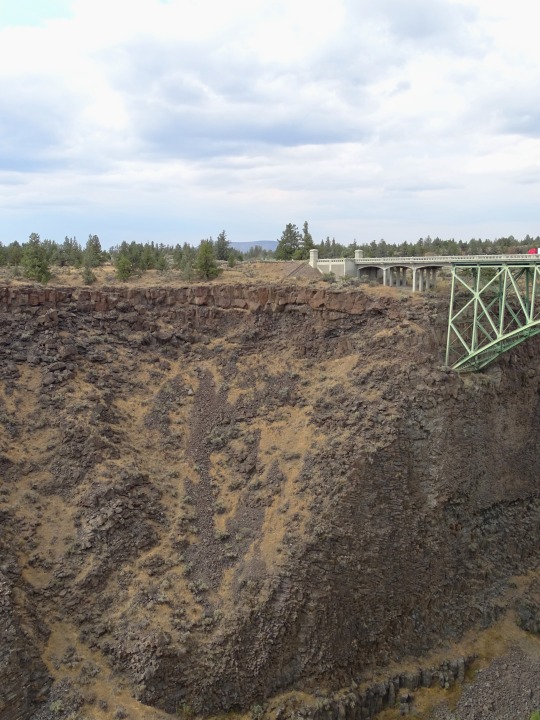
Peter Skene Ogden State Scenic Viewpoint, OR (No. 4)
The bridge was designed by the famous bridge architect, Ralph Modjeski, who also designed the San Francisco–Oakland Bay Bridge. The Missouri Valley Bridge & Iron Company built the bridge by cantilevering it out from rock walls on both sides of the canyon. A myth arose, fostered by a photograph of men climbing a rope ladder up to the bridge, that the bridge builders camped at the bottom of the canyon and climbed up to work every day. In fact the crew lived two miles north of the bridge in a large construction camp at Opal City. Opal City was expected to thrive well into the future but it was completely abandoned soon after the railroad was completed.
The first steel for the bridge arrived on May 18, 1911, and was lowered by derrick to the bottom of the gorge. Men climbed down rope ladders to attach cables to the steel beams and the steel was hoisted back up both sides of the canyon as the beams were needed. The first train crossed the bridge only four months later on September 17. Half the rivets holding the bridge together were installed after trains started using the bridge. The bridge was built quickly to facilitate laying the last 25.5 miles (41.0 km) of track to Bend where Jim Hill himself drove the "golden" spike on October 5. Dramatic photographs of the bridge's construction were taken by Olof Hedlund of Madras.
Less than 1⁄4 mile (0.40 km) upriver from the bridge are the Crooked River High Bridge, the Rex T. Barber Veterans Memorial Bridge (which carries U.S. Route 97 over the Crooked River), and the Peter Skene Ogden State Scenic Viewpoint. Further upriver the City of Prineville Railway, linking Redmond and Prineville, operates the only other railroad bridge across the Crooked River.
Source: Wikipedia
#Peter Skene Ogden State Scenic Viewpoint#Deschutes County#Jefferson County#Oregon#USA#summer 2023#Pacific Northwest#travel#original photography#vacation#tourist attraction#landscape#landmark#countryside#Terrebonne#Crooked River#Crooked River Railroad Bridge#architecture#engineering#Crooked River Railroad Bridge by Ralph Modjeski#flora#tree#nature#Crooked River Gorge#Crooked River High Bridge#Conde McCullough
6 notes
·
View notes
Text
US people who care about railroads should definitely read the Corridor ID Selections. While it was published a little over a year ago, the program is designed to fund shovel-ready programs and dedicate money to assessing the viability of corridors which would be either new or upgraded, and they just posted a massive update to the map including new HSR viability studies.
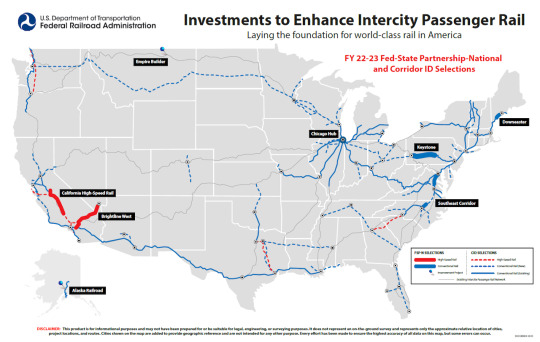
A partial list of served cities:
High speed rail candidates
San Francisco, Anaheim, LA, Vancouver, Portland, Seattle, Eugene, Charlotte NC, Atlanta, Dallas, Fort Worth, Houston, Las Vegas, Palmdale
New Conventional rail candidates
Asheville NC, Salisbury NC, Savannah GA, Chattenooga TN, Nashville, Memphis, Baton Rouge, New Orleans, Boston, Albany, San Jose, San Luis Obispo, King's Mountain NC, Moline IL, Naperville IL, Wyanet IL, Chicago, Fort Wayne IN, Columbus OH, Pittsburgh PA, Cleveland OH, Cincinnati OH, Dayton OH, Toledo OH, Detroit MI, Coachella CA, Fullerton CA, Indio CA, Riverside CA, Palm Springs CA, Fort Collins CO, Pueblo CO, Denver CO, Boulder CO, Colorado Springs CO, Newport News VA, Charlottesville VA, Roanoke VA, Richmond VA, Dover DE, Wilmington DE, Berlin MD, St Paul-Minneapolis MN, Eau Claire WI, Fayetteville NC, Raleigh NC, Lillington NC, Fuquay-Varina NC, Mobile AL, Bay St. Louis, Gulfport, Biloxi, Pascagoula MS, Houston, San Antonio, Rosenburg TX, Flatonia TX, Seguin TX, Meridian MS, Mineola TX, Longview TX, Marshall TX, Shreveport LA, Ruston LA, Monroe LA, Vicksburg MS, Jackson MS, Jacksonville FL, Miami FL, Orlando Fl, Tampa FL, Indianapolis IN, Louisville KY, Milwaukee, WI; La Crosse, WI; Eau Claire, WI; St. Paul, MN; Fargo, ND; Bismarck, ND; Dickson, ND; Glendive, MT; Billings, MT; Bozeman, MT; Butte, MT; Helena, MT; Missoula, MT; St. Regis, MT; Sandpoint, ID; Spokane, WA; and Pasco, WA, Duluth WA, Peoria IL, Phoenix, Tuscon, Maricopa, Reading PA, Scranton
These are most of the cities with new service
If you are between two of these cities, there is a serious chance you will have a train coming to you soon. Check the Doc for more as well as service upgrades on existing services
11 notes
·
View notes
Text
CSX train employees found metal materials jammed into the tracks and rail switches of an Ohio train line for months after a near-catastrophic derailment in August, according to court documents.
During a test run for a CSX employee appreciation day, a train hit an obstruction on the track and temporarily derailed before the wheels dropped back into place.
The seemingly mysterious accident quickly became a concerning issue when employees continued to find more "purposefully placed" materials along the tracks, which matched methods taught by international terrorist groups to make homemade derail devices, court documents say.
The investigation led to Cleveland man Joseph Findley, 43, who was arrested and charged with terrorist attacks against railroad carriers.
Findley lives with his parents, who could not be reached by Fox News Digital. His mother told Fox 8, though, that her son is not a terrorist.
"He's never been a bad kid, never, he was always good. He’s no terrorist, somebody’s making that up," his mom told the local news outlet, which asked what would explain his alleged actions.
SAN FRANCISCO BAY BOATERS FORCED TO FIGHT OFF ‘PIRATES’ WHO ARE STEALING SHIPS
"Being depressed, because he lost his job, he lost his girlfriend, but he never did anything like that," she said. "They’re nuts, he’s not a terrorist. I think they all exaggerated it because he never did anything bad."
The Amtrak train along that line typically carries between 180 and 200 passengers twice per day, according to court documents.
The evidence and accusations
Evidence laid out by the FBI and federal prosecutors in court papers reviewed by Fox News Digital tell a different story.
After the derailment on August 12, CSX employees found obstructions, including tie plates, spikes and other pieces of metal, wedged between the guardrail and the rail, according to the criminal complaint.
Findley allegedly jammed these metal objects in the line five times from August to October.
"The objects and their specific placement indicate knowledge of how the tracks and the switch operate, as well as how to disrupt these normal operations," the criminal complaint says.
A local business near the tracks caught a glimpse of a man in the area of the obstruction that caused the August 12 derailment and repositioned its cameras to get a clearer view of the tracks, court documents say.
"Over the next few days, CSX work crews reported several pieces of debris were placed on the tracks further east of the switch," the criminal complaint says.
"This debris consisted of two fiberglass panels and various pieces of track material, including tie plates and spikes."
The spikes are sharp and pointed upwards "to cause harm to someone walking around the railroad tracks," the complaint says.
Cameras caught the first glimpse of the suspect – a man wearing a black shirt, jean shorts and carrying an aluminum beverage can – on August 18, but investigators could not make out the man's face.
There was a lull in activity near the tracks until September 18, when crew members found material between the guardrail and the rail for the mainline.
"Based on the condition of the material, it appeared to have been struck by at least one train," according to the criminal complaint, but luckily there were no derailments.
How investigators found Findley
A day earlier – September 17 – trail cameras caught the same man from August 18 in the same clothing, but this time his face was clearer.
Investigators followed his movements, and saw him check the switches where the obstructions were, according to court documents.
The same man was spotted in the same spot on September 30 and October 1, when he was "seen taking several pieces of track material and placing them on other parts of the rail."
Investigators showed the images from the secret trail cam to a number of nearby store employees, and one of them identified Findley.
The clerk told investigators Findley grew up in the neighborhood, lives with his parents on a dead-end rotary and "is known to drink heavily," court documents say.
The FBI executed a search warrant on Findley's home, found the clothes seen in the surveillance videos and arrested him.
What Findley allegedly told investigators
Findley allegedly admitted to being the man in the surveillance videos and placing railroad spikes on the tracks, the criminal complaint says.
However, he denied jamming the other objects in the tracks and said he did not intend to derail a train.
He was represented by assistant public defender Ashlynn Mejia, who did not immediately respond to Fox News Digital's request for comment.
#nunyas news#i used to stick stuff on the tracks#so the train would smush it#not just pennies#but nothing so large as those plates
13 notes
·
View notes
Video
youtube
LONGEST INTERURBAN ELECTRIC RAILROAD IN THE US
May 30, 2024 This DVD production is available from our website at www.cspmovies.com. Below is the description of the full production.
Three electric lines in one video. The Sacramento Northern, SP Red Trains and the Peninsular Ry. We bring the SP ferry boats on the San Francisco Bay as well. This 1910 to 1957 history has been a favorite of rail-fans and historians.
Our scenes in Oakland, Berkeley and the Oakland Hills plus Sacramento Northern lines out to Contra Costa County are the essential Eastbay of a by-gone era. See the SN’s ferryboat that linked the south-end to the north-end carrying entire trains, both passenger and freight, from Chips to Mallard. The Sacramento Northern freight trains and the interchange with the electric Oakland terminal line at 40th & Shafter yard may very well be the best ever!
Follow several freights through the Oaklnad Hills, Montclair, the long tunnel and through Redwood Canyon to Moraga. From there we run out to Walnut Creek, Concord and the “subway” crossing under Santa Fe and SP tracks.
To quote a review in Railfan & Railroad magazine, “The 16mm film used in this program was shot by almost 20 photographers and ranges from very-good to excellent. This is another excellent and highly educational program from this producer….”
To quote a review in Model Railroad News, “He takes old 8 and 16mm film and spins it into gold….If you’re not already a traction fan, this video may push you over the edge!”
4 notes
·
View notes
Text
Get to know you tag
Yoinking an open tag from @blind-the-winds because it's been a hot minute since I've done one of these.
last song:
On the Railroad, performed by Colm McGuinness. It's a work song about building the First Transcontinental Railroad from Nebraska to San Francisco Bay. I'm particularly attached to this song, because it reminds me of when I traveled that route.
favorite color:
Let's go with 'vibrant rainbow' because I'm not really having an strong favourite colour at the moment. The Gent sent me a bouquet of pinks and purples and whites. The crocuses in the balcony are mostly yellow. The Housemate made some lego roses which are deep red. Everything else is shades of green, and the show I'm watching is filled with cyber blue.
currently reading:
Red Team Blues by Cory Doctorow. A very interesting story about an older forensic accountant who gets wrapped up in mafia wars to do with moving money through cryptocurrency. I'm learning a lot from it which I can use in Haven's Ember.
Countdown to Zero Day by Kim Zetter and Count Zero by William Gibson are on the backburner for now.
sweet, spicy, or savoury:
Sweet. I've had a really bad craving for ice cream for the past few days. I'm blaming how terrible the weather is.
last thing i searched online:
"green vegetables that start with a P" - On the way to my mum's yesterday we were talking about the sorts of things one can put in SpagBol, and Mum couldn't remember the name of a vegetable: "it begins with P" and I couldn't remember any veg names so I turned to the internet for help.
The vegetable she was thinking of was sPinach.
current obsession:
I've got a couple of things on the go, but none of them are really obsessions?
I'm editing a fanfic AU from 2017, which is bringing back ~emotions~. But it's also slowly getting posted on my main blog
I'm thinking about the next art project I want to do
I've been binge-watching my way through The Expanse which is awesome. I've not had a good space opera fix in a while (not counting Space Opera by Catherynne M. Valente which I read over xmas and was very fun)
Open tag! Tag me back if you yoink it so I can read all about you :D
4 notes
·
View notes
Text

CN Southwell "Port of San Francisco". Tannenbaum & Hawks knock around C&D Hoppers on Pier 80 in the late afternoon. ALCO S2 #23 has spent all of her 70+ years knocking around the docks here. The San Francisco Bay Railroad operates the remains of the ol' San Francisco Belt, mostly truncated now to a yard off of Cargo Way south of the Dogpatch https://flic.kr/p/WDMmuJ
12 notes
·
View notes
Text

Charles Beck - Tomales Bay
Tomales Bay is a place I often visit to kayak and fish. Interesting place where, in 1870 or so, the railroad ran along the edge of the bay taking people from San Francisco to the Russian River and hauling virgin redwood timber back to build the city.
All the marshy area at the mouth of Walker Creek/Keyes Creek was not there long ago. Soil eroded from intensive potato farming and filled much of the waterway. In 1860 flat bottomed schooners could travel to just below the town of Tomales to load the potatoes and other farm products. They then went down the creek/river to the bay and out the bar into the ocean and on to San Francisco. Still a beautiful place.
2 notes
·
View notes
Text

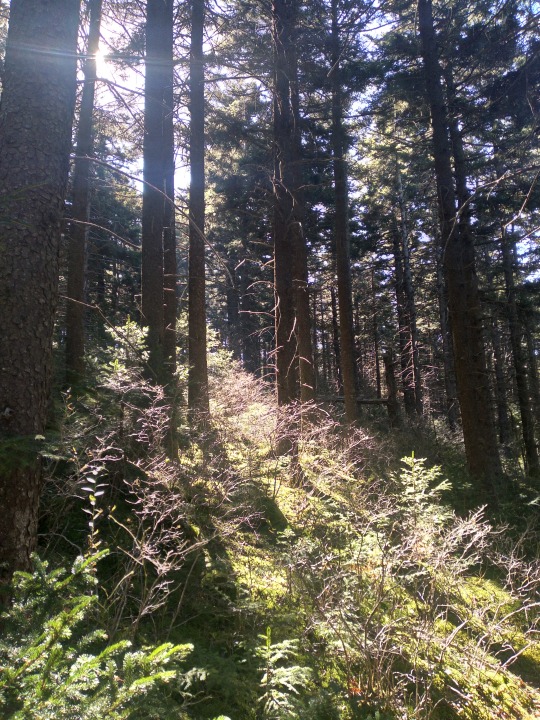
I've seen, in recent months, a few people online talking about the 'spirit' or 'character' of landscapes, and this is a topic I have Strong Opinions about. I do not trust my intuition about the character of people much at all, but I trust my intuition about the character of landscapes implicitly. A skeptic might say that this is because landscapes don't have a 'spirit,' and thus my intuitions can never be proven wrong. Well, perhaps, but I'm going to indulge myself anyway.
In particular, the Appalachians have a reputation for being dark and sinister and forboding, and have for about as long as English speakers have known about them. Obviously the trope of the darksome woods is very old in European culture, and makes sense for an agricultural civilization for whom forest clearance directly leads to greater wealth. But the reputation of the Appalachian mountains is a separate thing, distinct in kind and degree from that of the Yankee's North Woods, the southern pinelands, or the forests of the mountain west. All of those were 'tamed' by American industry and literature. But no amount of coal-mining, railroad-building, or poetry-composing has dimmed the folkloric reputation of the Appalachians as a landscape haunted by dark forces. There's certainly a Marxist perpective that it's just because they're remote and full of poor people, but there's plenty of remote places with lots of poverty that do not have this reputation for the land itself being anti-human.
Over the past few years, I've had the opportunity to spend much more time in Appalachia than I ever previously had, and I've come to believe that this bit of American belief is wrongheaded. The hills and forests of Appalachia do not seem at all sinister to me, but instead give an impression of great peace. The hills and forests are old here, old and powerful beyond measure, to be sure, but I find them kindly, as if they had found in their great age an acceptance of the ways of things and that sense of Oneness With All Things we are told mystics strive for. Yes, I do find all forests (at least, all temperate forests) kindly to me in particular, because I love them so much and they condescend to return the favor. But I can still recognize that certain trees (spruces in general and Sitka spruces in particular; and willows in general and sandbar willows in particular) have in them a deeply inhuman spirit, inimical to us and perhaps to all animal life. But I find nothing like this in the Appalachian forests, and it is perhaps notable that they are crowned by red spruces, probably the least sinister member of the genus.
But there is a sinister geography in the region, and one that probably explains the ill reputation of the whole area. It's not the hills, though, and not the forests. It's the rivers. The Ohio river and all her tributaries seem to me to carry a dark, ferocious, brooding energy, that leaks out into the landscape immediately adjacent even farther than their floodwaters. To the physiognomist of landscapes, these constricted valleys seethe with angry inhuman spirits. When the morning fog rolls in from the river to blanket Portsmouth, Ohio, it's a very different feeling from the same thing happening in the San Francisco Bay. And since these valleys are also the corridors through which all human traffic in the region moves, all who travel in or through the area take this impression with them, however subconsciously.
This sees some reflection in folklore, too: the most famous 'cryptid' of the area, the mothman, was sighted around Point Pleasant, WV. For people from New York or Chicago, this is just one more random Appalachian mountain town, doubtlessly full of hillbillies. But no, Point Pleasant is a low-lying, (ex-)industrial river town. The great tragedy the mothman is associated with was even the collapse of a bridge over the Ohio River itself!
This may all be silly, pretentious gobbledygook. It's definitely silly and pretentious. And even if it isn't gobbledygook, I'm not occultist enough - or even necessarily believing enough in the supernatural - to speculate why this is, what causes this, or if it's anything more than a wannabe poet's fancy. But I still trust my readings of landscapes, and would like to see the vocabulary of the good and kindly hills (especially as contrasted with the cruel and violent valleys) enter the repertoire of Appalachian landscape writers.
4 notes
·
View notes
Text
Ok but that last one on the last addition makes me think of my father Vs. Stepdad.
My father is the type that would just tolerate going places with my mom and I, and when they divorced and it was just me and him going places, would mostly just follow while I read everything and stayed quiet, because I knew he wouldn’t react well to hearing me talk.
My stepdad? Has literally said he’d love to go the Monterey Bay Aquarium (where he has never been) with me specifically because he knows I know a lot about the ocean, and he’d be able to learn even more from me than what was just on the plaques. And vice versa. We just went to a model train show the first week in October, and it was so fun to see the models, but also really fun to listen to him explain the real counterparts of things, as he worked for BNSF for several years in the past. I absolutely loved learning about the different ways switches are used, how common or uncommon certain types of switches/tracks/switchbacks were, and the history of the actual railroad companies (I never knew that BNSF stands for Burlington Northern Santa Fe after the two lines that merged to create it, I always thought it had something to do with San Francisco).
There’s so many reason I changed my last name to my stepdad’s, but this is a big one for me. Being able to ramble and infodump and actually have it be listened to and appreciated is such a huge thing for me.
You shouldn’t date or become serious friends/partners with someone if you can’t stomach the thought of being stuck in a car or train with them for 16 hours.
199K notes
·
View notes
Text

William H Chester (January 6, 1914 - November 3, 1945) was born in Shreveport, his mother’s maiden name was Fuller. He moved with his parents to Kansas City, Missouri. His father, a railroad worker, died when he was 11. He spent two years at Western College.
He enlisted in the 25th Infantry Regiment of the Army, a famed all-Black unit, for three years. He traveled to San Francisco, where he worked on barges and joined the ILWU, Local 10.
When he joined the union in 1938, fewer than 100 Blacks belonged. San Francisco’s port boomed in WWII, allowing thousands of African American workers to find jobs on the waterfront. He was called back into the Army until the war ended. He was reinstated to Local 10.
The ILWU was one of the few unions in San Francisco where Blacks could get a job without discrimination. He helped form a Black Caucus in Local 10. This group pushed to ensure representation of all races when new members were admitted to the union. They started recruiting from impoverished Bay Area Black communities.
He was appointed as Northern California Regional Director where he served for 18 years. He was appointed West Coast Regional Director and Vice President of the National Negro Labor Council. He was elected an ILWU Vice President.
His civil rights efforts involved the larger Bay Area and African American communities beyond ILWU membership. He helped conceive and organize a march of 20,000 and a rally of 30,000 civil rights supporters in San Francisco. The largest civil rights demonstration in the region’s history, signaled Bay Area solidarity with the Black civil rights demonstrators then confronting police in Birmingham.
He led the effort to make Dr. Martin Luther King, Jr. an honorary ILWU member. King visited Local 10’s hall and hailed the ILWU for promoting racial equality and uplifting poor people into the middle class.
San Francisco Mayor Joseph Alioto appointed him to the Board of Directors of the Bay Area Rapid Transit District. He rode the first official train to travel underneath the San Francisco Bay.
He was survived by his wife, Ethel V. Johnson (1940), one son and one daughter. #africanhistory365 #africanexcellence
0 notes